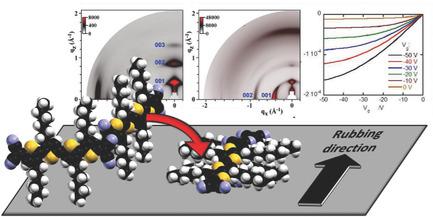当前位置:
X-MOL 学术
›
Adv. Funct. Mater.
›
论文详情
Our official English website, www.x-mol.net, welcomes your
feedback! (Note: you will need to create a separate account there.)
Simultaneous Edge‐on to Face‐on Reorientation and 1D Alignment of Small π‐Conjugated Molecules Using Room‐Temperature Mechanical Rubbing
Advanced Functional Materials ( IF 18.5 ) Pub Date : 2018-03-12 , DOI: 10.1002/adfm.201707038 Jean‐Charles Ribierre 1, 2 , Toshihiko Tanaka 3 , Li Zhao 1 , Yuki Yokota 4, 5 , Shinya Matsumoto 4, 5 , Daisuke Hashizume 6 , Kazuto Takaishi 5 , Tsuyoshi Muto 5 , Benoît Heinrich 7 , Stéphane Méry 7 , Fabrice Mathevet 8 , Toshinori Matsushima 1, 2, 9 , Masanobu Uchiyama 5, 10 , Chihaya Adachi 1, 2, 9 , Tetsuya Aoyama 5
Advanced Functional Materials ( IF 18.5 ) Pub Date : 2018-03-12 , DOI: 10.1002/adfm.201707038 Jean‐Charles Ribierre 1, 2 , Toshihiko Tanaka 3 , Li Zhao 1 , Yuki Yokota 4, 5 , Shinya Matsumoto 4, 5 , Daisuke Hashizume 6 , Kazuto Takaishi 5 , Tsuyoshi Muto 5 , Benoît Heinrich 7 , Stéphane Méry 7 , Fabrice Mathevet 8 , Toshinori Matsushima 1, 2, 9 , Masanobu Uchiyama 5, 10 , Chihaya Adachi 1, 2, 9 , Tetsuya Aoyama 5
Affiliation

|
In this study, room‐temperature mechanical rubbing is used to control the 3D orientation of small π‐conjugated molecular systems in solution‐processed polycrystalline thin films without using any alignment substrate. High absorption dichroic ratio and significant anisotropy in charge carrier mobilities (up to 130) measured in transistor configuration are obtained in rubbed organic films based on the ambipolar quinoidal quaterthiophene (QQT(CN)4). Moreover, a solvent vapor annealing treatment of the rubbed film is found to improve the optical and charge transport anisotropy due to an increased crystallinity. X‐ray diffraction and atomic force microscopy measurements demonstrate that rubbing does not only lead to an excellent 1D orientation of the QQT(CN)4 molecules over large areas but also modifies the orientation of the crystals, moving molecules from an edge‐on to a face‐on configuration. The reasons why a mechanical alignment technique can be used at room temperature for such a polycrystalline film are rationalized, by the plastic characteristics of the QQT(CN)4 layer and the role of the flexible alkyl side chains in the molecular packing. This nearly complete conversion from edge‐on to face‐on orientation by mechanical treatment in polycrystalline small‐molecule‐based thin films opens perspectives in terms of fundamental research and practical applications in organic optoelectronics.
中文翻译:

使用室温机械摩擦同时对小π共轭分子进行从边到面的重新定向和一维对齐
在这项研究中,室温机械摩擦用于控制溶液处理的多晶薄膜中小π共轭分子系统的3D取向,而无需使用任何取向衬底。在基于双极性醌型四噻吩(QQT(CN)4)的摩擦有机膜中,获得了晶体管配置中测得的高吸收二色性比和显着各向异性的电荷载流子迁移率(高达130)。而且,发现由于摩擦的膜的溶剂蒸汽退火处理由于增加的结晶度而改善了光学和电荷传输各向异性。X射线衍射和原子力显微镜测量表明,摩擦不仅会导致QQT(CN)4分子在大面积上具有出色的一维取向,而且会改变晶体的取向,将分子从边缘结构移动到面对结构。通过QQT(CN)4层的塑性特性和柔性烷基侧链在分子包装中的作用,合理地解释了为何可以在室温下将机械取向技术用于此类多晶膜的原因。通过在多晶小分子薄膜中进行机械处理,从边到边取向几乎完全转变为有机光电子学的基础研究和实际应用开辟了前景。QQT(CN)4层的塑性特征以及柔性烷基侧链在分子堆积中的作用。通过在多晶小分子薄膜中进行机械处理,从边到边取向几乎完全转变为有机光电子学的基础研究和实际应用开辟了前景。QQT(CN)4层的塑性特征以及柔性烷基侧链在分子堆积中的作用。通过在多晶小分子薄膜中进行机械处理,从边到边取向几乎完全转变为有机光电子学的基础研究和实际应用开辟了前景。
更新日期:2018-03-12
中文翻译:

使用室温机械摩擦同时对小π共轭分子进行从边到面的重新定向和一维对齐
在这项研究中,室温机械摩擦用于控制溶液处理的多晶薄膜中小π共轭分子系统的3D取向,而无需使用任何取向衬底。在基于双极性醌型四噻吩(QQT(CN)4)的摩擦有机膜中,获得了晶体管配置中测得的高吸收二色性比和显着各向异性的电荷载流子迁移率(高达130)。而且,发现由于摩擦的膜的溶剂蒸汽退火处理由于增加的结晶度而改善了光学和电荷传输各向异性。X射线衍射和原子力显微镜测量表明,摩擦不仅会导致QQT(CN)4分子在大面积上具有出色的一维取向,而且会改变晶体的取向,将分子从边缘结构移动到面对结构。通过QQT(CN)4层的塑性特性和柔性烷基侧链在分子包装中的作用,合理地解释了为何可以在室温下将机械取向技术用于此类多晶膜的原因。通过在多晶小分子薄膜中进行机械处理,从边到边取向几乎完全转变为有机光电子学的基础研究和实际应用开辟了前景。QQT(CN)4层的塑性特征以及柔性烷基侧链在分子堆积中的作用。通过在多晶小分子薄膜中进行机械处理,从边到边取向几乎完全转变为有机光电子学的基础研究和实际应用开辟了前景。QQT(CN)4层的塑性特征以及柔性烷基侧链在分子堆积中的作用。通过在多晶小分子薄膜中进行机械处理,从边到边取向几乎完全转变为有机光电子学的基础研究和实际应用开辟了前景。









































 京公网安备 11010802027423号
京公网安备 11010802027423号